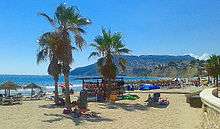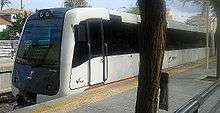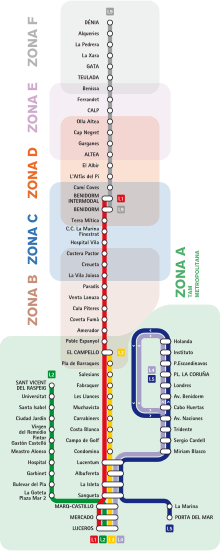Alicante (province)
Alicante / Alacant province is the southernmost province of the Valencian Community. The fourth-largest province in Spain (after Madrid, Barcelona and Valencia), the beautiful weather and glistening beaches of the Costa Blanca attracts tourists from across Europe. Many have chosen to stay and sizeable expatriate communities mean that a quarter of the province's population is foreign.

Cities
- 🌍 Alicante – the provincial capital.
- 🌍 Agost – a small town known for its traditional ceramics.
- 🌍 Cocentaina – has an annual 600-year-old trade fair.
- 🌍 Alcoy – has the largest annual Moors and Christians festival.
- 🌍 Biar – one of Alicante's better-preserved medieval towns.
- 🌍 Villena – a town with two Moorish castles and other historic monuments.
Other destinations
- Gran Alacant
- 🌍 Costa Blanca
- 🌍 Tabarca
Understand
It's easy to understand why tourism is Alicante's major industry. The spectacular landscape, stunning beaches and sunny climate attracts hundreds of thousands of tourists from across Europe each year, with visitors from the Netherlands, UK, Ireland, Germany, Belgium and France leading the way. Due to this, there are a large number of second homes in the province - many of which can be rented as holiday villas during the high season. More foreigners still have decided to make Alicante their home and a quarter of the population are from abroad - with the expatriate population reaching above 50% in 19 of the province's 141 municipalities.
Away from the beaches, the geography of the area makes Alicante a stunning area to explore, with the province split between mountainous areas to the north and west and a mostly flat south. The mountains are home to interesting villages to explore, such as Guadalest and natural gems like the Algar Waterfalls. The coast is dotted with relics from the region's past in the form of ancient towers and fortifications alongside hidden coves. The massive Penyal d'Ifac, in Calp, is a striking visual feature along the coastline and was known to the Phoenicians as the Northern Rock to distinguish it from the Rock of Gibraltar further south.
The region's culture is also particularly vibrant, with numerous festivals throughout the year. Almost every town and village celebrates the annual Moors and Christians festival in the summer, which commemorates the Spanish Reconquista and often leads to week long festivities.
Aside from tourism, the province relies on agriculture with vineyards in the inner part of the province and fertile land along the coast. Fishing is important along the coast and Santa Pola, Calp and Denia are all important fishing harbours. Historically, the textile sector - particularly footwear - has been important in towns such as Alcoy and Elche but the industry is now having to fight against harsh competition from Asia.
Get in
By plane
Using the international airport in Alicante (Valencian/Catalan: Alacant),ALC IATA.
The airport is relatively close to the ciutat (city) of Alacant, beaches in Costa Blanca, such as Benidorm.
By train

Trains coming from Madrid (Altaria), which takes about 3 hours and 15 minutes, and Barcelona and València (Euromed). It also has a picturesque (and slow) train coming from Dénia and going until Alicante. This is the so-called TRAM system. The tracks have been electrified, with ultra-modern cars, from Alicante to Benidorm. Between Benidorm and Denia, the line is still served by the old diesel traincars. There are plans to electrify the system from Benidorm to Denia as well.
By bus
Many buses come from almost every big city in Spain. The main bus station is located in the centre of Alicante.
Get around
By Tram

The Alicante metropolitan area and the Costa Blanca are connected by the Alicante Metropolitan TRAM. The services stretches from Alicante to Denia in the north, 90km up the coast, with 71 station across 5 lines. The TRAM combines tram, light rail, light train and commuter services into one seamless integrated system.
Outside of the Alicante metropolitan area, the Line 1 serves towns along the coast from Alicante up to Bendiorm. From there, passengers can interchange with Line 9 for services further north serving towns including Altea, Calp, Teulada and Dénia. The journey from Alicante-Luceros to Benidorm takes approximately 70 minutes, while services from Benidorm to Denia take 90 minutes. Services between Calp and Denia have been closed since 2016 for upgrade works - replacement bus services are available instead.
A journey planner is available.
Fares range from €1.35 to €7.15 (April 2018 prices) for a single ticket depending on the number of zones traveled through. Multi-journey tickets and concessions are available which provide a discount. Within the Alicante metropolitan area, a single journey costs €1.45 but passengers can buy TAM multitravel cards, which provide discounts on multiple journeys.
See
- Guadalest (30min drive inland from Altea). Guadalest is a mountainous village built in a truly unique style into the actual mountain sides. The picturesque village attract thousands of tourist wishing to see the ancient buildings glued to the peaks of narrow mountains and habitats built into the caves of steep mountain sides
Do
Festivals
Moros i Cristians (Spanish: Moros y Cristianos) festivals are held in various small towns around the Alicante region. The festivity keeps memory of the Reconquer of each town by Christian kings of the territory to Islamic forces. Locals dress up in colorful costumes as Medieval Moorish and Christian warriors and knights. Live camels and elephants can sometimes be seen in street processions. In some areas, temporary wooden castles are built and mock battles are waged. Loud gunpowder arquebuses are discharged into the air, and fireworks can last late into the night.
Eat
Drink
Alicante has its own regulatory wine council. Tinto Alicante and Moscatel Alicante are the most well-known varieties.